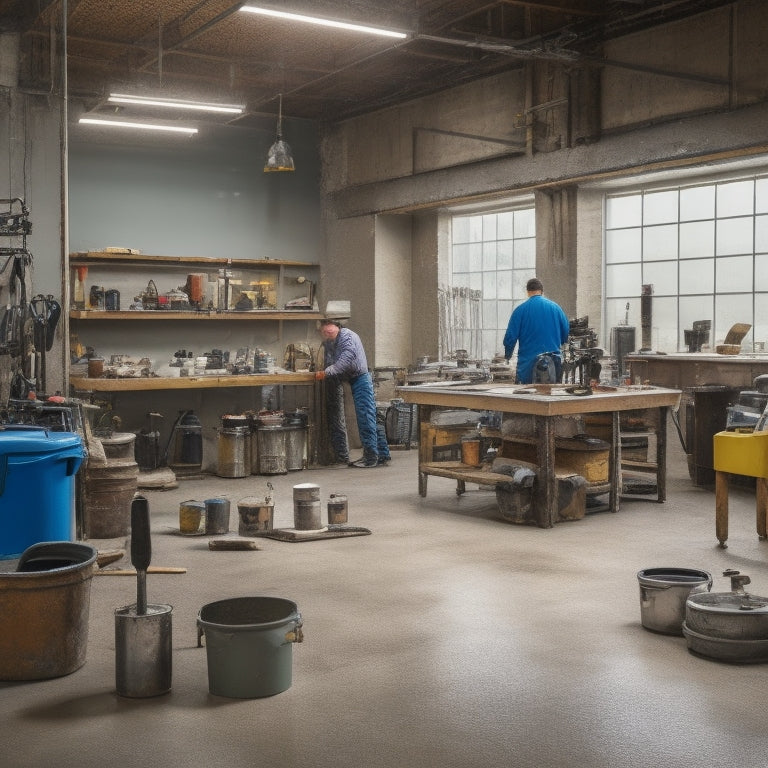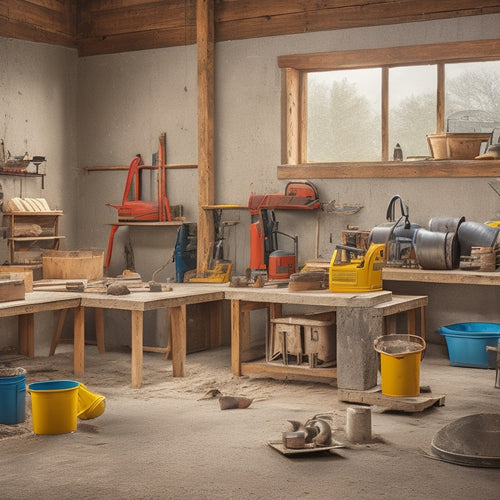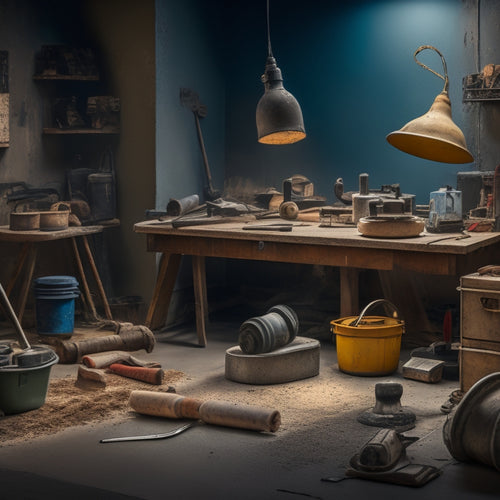
What Tools Do You Need for Concrete Sealing
Share
You'll need a range of tools and equipment for a successful concrete sealing project, including high-quality sealers, application tools like rollers and sprayers, and protective gear like gloves and safety glasses. Surface preparation equipment, such as pressure washers and wire brushes, is also essential for cleaning and preparing the surface. Additionally, you'll need measuring and mixing tools, like digital scales and mixing sticks, as well as specialized tools for removing old sealers and cleaning concrete blocks. With the right tools, you'll be well-equipped to achieve a strong bond and a long-lasting seal - and the next steps will help you get the job done right.
Key Takeaways
• Essential tools for concrete sealing include high-quality sealers, application tools, protective gear, and surface preparation equipment.
• Cleaning tools like brooms, leaf blowers, and pressure washers are necessary for effective debris removal and surface preparation.
• Surface preparation equipment, such as floor scrapers and wire brushes, help remove contaminants and ensure a strong bond between the sealant and concrete.
• Sealer application tools, including rollers, brushes, and sprayers, are specifically designed for even and consistent application.
• Safety gear, such as gloves, safety glasses, and respirator masks, are crucial for protecting yourself from chemicals and abrasive particles during the sealing process.
Essential Materials for Block Sealing
What materials do you need to seal your concrete blocks effectively? To reap the block sealing benefits, you'll require a few essential materials.
First, you'll need a high-quality concrete sealer that suits your block type and desired finish. Choose from acrylic, polyurethane, epoxy, or silicone-based sealers, depending on the level of protection and appearance you want to achieve.
Next, gather necessary application tools, such as a roller extension pole, microfiber roller cover, or a sprayer. Don't forget to wear protective gear like gloves, safety glasses, and a mask to prevent skin and respiratory irritation.
When it comes to sealing techniques, you'll need a clean, dry surface to guarantee ideal adhesion. Remove any dirt, oil, or old sealers before applying the new coat.
Apply the sealer according to the manufacturer's instructions, using the recommended application rate and technique. Some sealing techniques involve multiple coats, so be sure to follow the instructions carefully.
Cleaning Tools for Concrete Prep
When you're preparing concrete for sealing, you'll need to get rid of any debris and dirt that's accumulated on the surface.
You'll want to use the right cleaning tools to guarantee a strong bond between the concrete and the sealant.
Remove Debris and Dirt
Before applying a concrete sealer, you'll need to sweep or blow away loose debris and dirt from the surface using a broom, leaf blower, or pressure washer. This step is essential for effective debris removal and dirt disposal, ensuring a clean surface for sealing. Remove any leaves, twigs, or other loose particles that could interfere with the sealer's adhesion.
You may need to use a combination of tools depending on the amount and type of debris on your concrete surface. A broom is ideal for smaller areas with minimal debris, while a leaf blower is better suited for larger areas with heavier debris. If you're dealing with stubborn dirt or stains, a pressure washer can be used to blast them away. Be cautious not to use high pressure, as it can damage the concrete.
Remember to dispose of the removed debris and dirt properly to maintain a clean work environment. Once you've completed this step, you'll be ready to move on to the next stage of concrete preparation.
Power Washing Equipment
You'll likely need a power washer with a wide fan tip and a pressure rating of at least 1,500 pounds per square inch (psi) to effectively remove dirt, grime, and old coatings from the concrete surface. This will guarantee a thorough clean, allowing the sealant to adhere properly.
When selecting a power washer, consider the type that suits your needs. Electric power washers are suitable for smaller areas and are generally quieter, while gas-powered models are more powerful and ideal for larger surfaces.
Adjust the pressure settings according to the surface you're working on. For example, a lower pressure setting (around 1,000 psi) is suitable for cleaning delicate surfaces, such as stamped or decorative concrete. For heavier-duty cleaning, you can use a higher pressure setting (up to 3,000 psi).
Additionally, consider the type of nozzle you'll need. A wide fan tip (25° or 40°) is ideal for cleaning large areas, while a narrower tip (15° or 20°) is better suited for tight spaces or intricate surfaces.
Surface Preparation Equipment
Selecting the right surface preparation equipment is essential to guarantee a strong bond between the concrete and the sealant.
You'll need to determine the best surface treatment methods for your specific project, as this will impact the effectiveness of your sealing techniques.
A vital step in surface preparation is removing dirt, oil, and other contaminants that can interfere with the sealant's adhesion.
You'll need a floor scraper or grinder to remove old coatings, dirt, and other substances. A wire brush or broom can also be used to remove dirt and debris.
For more aggressive cleaning, consider using a shot blaster or scarifier to roughen the surface and create a better bond. Additionally, you may need to use a vacuum or blower to remove dust and debris.
Sealer Application Tools Needed
To apply sealers efficiently and effectively, equip yourself with the right tools, including rollers, brushes, and sprayers specifically designed for concrete sealing. These tools will help you achieve a uniform coat and prevent wastage.
When using rollers, opt for microfiber or lambswool rollers, which are designed to pick up and release the sealer evenly. Roller methods involve working in sections, applying the sealer in a 'W' or 'M' pattern to guarantee complete coverage.
For smaller areas or detailed work, brushes are ideal. Choose brushes with natural bristles or high-quality synthetic fibers that can handle the solvent-based or water-based sealers.
When using sprayers, master sprayer techniques such as maintaining a consistent distance from the surface, moving in a steady, back-and-forth motion, and adjusting the spray nozzle to achieve the desired fan pattern. This will help you achieve a smooth, even finish.
Safety Gear for Concrete Sealing
When you're working with concrete sealers, you're dealing with chemicals that can be hazardous to your health.
You'll need to gear up with the right personal protective equipment to prevent exposure.
From breathing masks to eye protection, it's essential that you cover all your bases to guarantee a safe and successful sealing job.
Personal Protective Equipment
You'll need to wear the right personal protective equipment (PPE) to safeguard yourself from the harsh chemicals and abrasive particles involved in concrete sealing. This is essential for your personal safety, as it will protect you from skin irritation, allergic reactions, and other potential health risks.
When it comes to personal protective gear, you'll want to prioritize the following vital items:
-
Long-sleeved shirts and pants: These will prevent skin exposure to chemicals and particles, reducing the risk of skin irritation and reactions.
-
Closed-toe shoes: Steel-toed boots or shoes with a non-slip sole are a must-have to prevent foot injuries and slips.
-
Gloves: Chemical-resistant gloves will protect your hands from harsh substances and abrasive particles, ensuring you can work safely and efficiently.
Breathing and Eye Protection
Your respiratory system and eyes require specialized protection from the concrete sealer's harmful fumes and particles.
As you work with concrete sealers, you're exposed to respiratory hazards that can cause long-term damage. It's essential to prioritize ventilation importance to minimize the risks.
When selecting breathing protection, opt for a respirator mask with an organic vapor cartridge. This will filter out solvent-based fumes and particles, ensuring you breathe safely. Don't settle for a dust mask, as it's not designed to protect against chemical fumes.
For eye protection, wear goggles or safety glasses with a seal around the eyes. This will prevent sealer splashes or spills from entering your eyes. Make sure the lenses are scratch-resistant and provide UV protection.
Measuring and Mixing Tools
As you prepare to seal your concrete, it's vital to get the mixing process right. Measure accurately with digital scales or measuring cups to confirm the correct proportions of sealant and hardener are combined. This guarantees a strong bond between the two components, resulting in a durable and long-lasting seal.
To achieve ideal mixing results, you'll need the right tools. Here are some essentials to add to your kit:
-
A mixing stick or paddle: This helps to scrape the sides and bottom of the mixing container, making sure all ingredients are well incorporated.
-
A clean and dry mixing container: Avoid using containers with residue or moisture, as this can affect the sealant's performance.
-
A timer or stopwatch: This helps you maintain the recommended mixing time, ensuring the sealant and hardener are fully incorporated and the mixture is homogeneous.
Concrete Block Cleaning Brushes
Before applying a concrete sealer, use concrete block cleaning brushes to remove dirt, grime, and old sealers from the surface, guaranteeing a strong bond between the old and new materials. This vital step in block surface maintenance is often overlooked, but it's essential for a successful sealing process. You'll need to choose the right brush type for your specific concrete surface.
There are two primary brush types: nylon-bristled and wire-bristled brushes. Nylon-bristled brushes are gentle on the surface and ideal for removing dirt and grime, while wire-bristled brushes are more aggressive and better suited for removing old sealers or stubborn stains.
Comparing brush types, wire-bristled brushes are more effective at removing heavy buildup, but they can scratch the surface if used too aggressively. Nylon-bristled brushes, on the other hand, are safer for the surface but may require more elbow grease to get the job done.
Sealant Removal Tools Required
Removing old sealers and coatings from concrete surfaces requires specialized tools designed to break down and extract the existing sealant without damaging the underlying concrete.
You'll need to choose the right tools based on the type of sealant you're removing and the application techniques used initially. For instance, if you're dealing with a solvent-based sealant, you'll need a tool that can effectively break down the solvent without spreading it further.
Here are some essential sealant removal tools you'll need:
-
Scrapers and putty knives: for manually scraping off the old sealant
-
Chemical strippers: for breaking down and dissolving the sealant, making it easier to remove
-
Power washers and scrubbers: for aggressive removal of thick, old coatings
Remember to always follow the manufacturer's instructions for the removal tool and take necessary safety precautions to avoid damaging the concrete or exposing yourself to harsh chemicals.
Finishing Touches Equipment List
You'll need a set of specialized tools to put the finishing touches on your newly sealed concrete surface, guaranteeing a professional-looking finish and long-term durability. As you explore various finishing techniques, you'll want to take into account the equipment required to achieve the desired aesthetic and functionality.
Here's a breakdown of the essential tools you'll need for the finishing touches:
| Tool | Description | Purpose |
|---|---|---|
| Microfiber cloths | Soft, absorbent cloths | Removing excess sealant and cleaning the surface |
| Lambswool applicators | Soft, natural fiber applicators | Applying sealant evenly and consistently |
| Roller extension poles | Adjustable, extendable poles | Reaching high areas and applying sealant efficiently |
| Sealant spreaders | Notched or flat spreaders | Spreading sealant evenly and achieving uniform thickness |
| Concrete brooms | Stiff-bristled brooms | Texturing the surface for decorative options |
With these tools in your arsenal, you'll be able to achieve a high-quality finish that showcases your decorative options and enhances the overall appearance of your concrete surface. Remember to choose the right tool for the job to guarantee a professional-looking finish that lasts.
Frequently Asked Questions
Can I Use a Regular Paint Roller for Concrete Sealing?
You might think a regular paint roller would work for concrete sealing, but it's not the best choice.
The roller types designed for concrete sealing have thicker, more durable nap materials that can handle the thick, viscous sealers.
Plus, the application techniques for concrete sealing require a more aggressive roll pattern to guarantee proper adhesion and coverage.
Using a regular paint roller can lead to uneven application, wasted sealer, and a subpar finish.
Invest in the right tools for a professional-looking result.
How Long Does It Take for Concrete Sealer to Fully Dry?
You're probably wondering how long it takes for concrete sealer to fully dry. The answer depends on the type of sealer you're using and environmental conditions.
Typically, the drying time ranges from 30 minutes to an hour, but it can take up to 24 hours for the sealer to fully cure.
During the curing process, make sure to follow the manufacturer's instructions and avoid exposing the sealed surface to heavy traffic or water.
Can I Seal Concrete in Direct Sunlight or High Winds?
When sealing concrete, you'll want to avoid direct sunlight and high winds.
Sunlight effects can cause the sealer to dry too quickly, leading to uneven coverage and a weaker bond.
Wind considerations are also essential, as gusts can blow debris onto the wet sealer or disturb its application.
Instead, choose a cloudy day or work in a shaded area with minimal wind to guarantee a smooth, successful seal.
Is It Necessary to Test the Sealer on a Small Area First?
You're wise to wonder if testing the sealer on a small area first is necessary. The answer is a resounding yes!
You need to confirm the sealer's compatibility with your concrete. Testing methods are essential to avoid costly mistakes.
Apply the sealer to a discreet area, let it dry, and inspect the results. This simple step will save you time and money in the long run, ensuring a successful sealing project.
Can I Apply Concrete Sealer to Damp or Wet Surfaces?
Did you know that over 80% of concrete sealing failures are due to improper surface preparation?
When it comes to applying concrete sealer, you can't skip this essential step.
You shouldn't apply sealer to damp or wet surfaces, as it can lead to uneven absorption and poor adhesion.
Make sure you prepare the surface properly by cleaning and drying it thoroughly before sealer application.
This will guarantee a strong, long-lasting bond between the sealer and the concrete.
Conclusion
You've got all the necessary tools for concrete sealing. Now, put them to use. Remember, proper preparation is key.
For instance, a hotel in Miami saved thousands of dollars in maintenance costs by sealing their concrete parking garage. They used a pressure washer and cleaning solutions to prep the surface, then applied a silane-based sealer.
The result? A durable, stain-resistant finish that's withstood heavy foot and vehicle traffic for years.
Related Posts
-

What Tools to Rent for a Concrete Home Reno
When tackling a concrete home renovation, you'll need to rent a variety of specialized tools to get the job done. For...
-

Top Concrete Resurfacing Tools for a Pro Finish
When it comes to achieving a professional finish in concrete resurfacing projects, you require the right set of speci...
-

10 Best Tools for Sealed Concrete Finishing Success
When it comes to sealed concrete finishing success, you need a robust arsenal of specialized tools. Start with essent...


